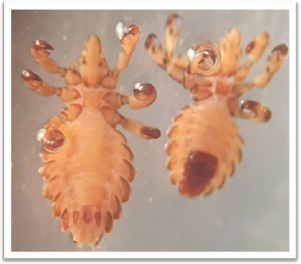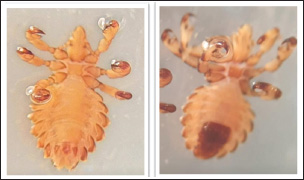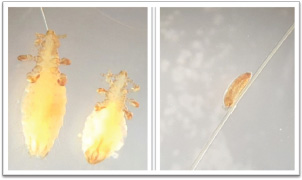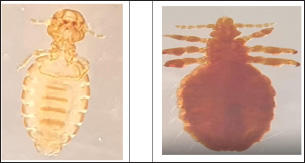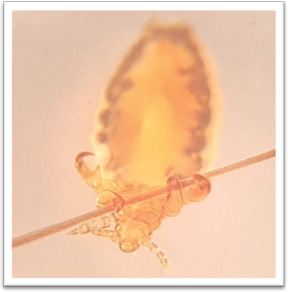
| Research Article | ||
Open Vet. J.. 2025; 15(8): 3794-3797 Open Veterinary Journal, (2025), Vol. 15(8): 3794-3797 Research Article A descriptive-taxonomic study of two types of lice isolated from goats in the Basrah Governorate, IraqSuzan A. Al-Azizz1*, Nadia K. Thamer1 and Huda Sh. Farhan21Department of Veterinary Parasitology, College of Veterinary Medicine, University of Basrah, Basrah, Iraq 2Department of Clinical Laboratory, College of Pharmacy, University of Basrah, Basrah, Iraq *Corresponding Author: Suzan A. Al-Azizz. Department of Veterinary Parasitology, College of Veterinary Medicine, University of Basrah, Basrah, Iraq. Email: suzan.azizz [at] uobasrah.edu.iq Submitted: 25/02/2025 Revised: 28/06/2025 Accepted: 14/07/2025 Published: 31/08/2025 © 2025 Open Veterinary Journal
ABSTRACTBackground: Pediculosis is an infestation of warm-blooded animals, and it is an important economic problem for various livestock and poultry hosts. Lice are termed direct parasites because they produce skin imperfections at tanneries because of the irritation they create during feeding. The feeding process triggers irritation or itching in the skin, resulting in rubbing and scratching. Aim: The study isolated, described, and diagnosed two biting and sucking lice species in goats in Basrah City, Saudi Arabia. Methods: A total examination of 50 male and female goats was performed for lice collection and isolation from October 1, 2018 to April 1, 2019, noted. The lice were preserved in clean vials containing 70% ethyl alcohol. Results: The study identified two groups of veterinary lice infesting goats: sucking lice in the order Anoplura and biting lice in the order Mallophaga. Haematopinus tuberculatus was observed (prevalence of 64%), Linognathus africanus (prevalence of 38%), and Bovicolaovis (prevalence of 24%). Notably, the overall infection rate with lice was 100%, and examples of mixed infections with greater than one lice species on individual animals were observed on the animals in localized areas of the body, such as the back, udder, and other regions. Conclusion: This study documents the first-ever report of a new species of sucking and chewing lice in Basrah City, indicating that both species share a common host. Keywords: Lice, Goats, Anoplura, Mallophaga. IntroductionLice have been recognized as a small, wingless parasitic insects that live on the skin of mammals and birds causing severe itching, damage and scratching of the host skin while feeding on its blood (Mersha, 2013; Yacob, 2014). To date, nearly five thousand species of lice have been classified into four suborders. Sucking lice, which only feed on the blood of eutherian mammals, are classified into the Anoplura suborder (Durden and Musser, 1994). Chewing lice infest birds and mammals and consume feathers, dead skin, blood, or secretions. They are classified into three other suborders: Amblycera, Ischnocera, and Rhynchophthirina (Johnson and Clayton, 2003). Sucking lice (Phthiraptera: Anoplura) are permanent host-specific ectoparasites of eutherian mammals that cause economic stress to farmers through weight loss, hide damage, and varying states of anemia from too much (Otter et al., 2003). Lice have been reported to infest a variety of domestic mammals, such as cows, buffalo, sheep, horses, goats, dogs, and camels; and humans (Hasson and Al-Zubaidi, 2014). Host animals infested with lice generally show poor bodily condition indicative of a common aspect of infestation, i.e., they appear anemic, lethargic, and clearly have matted oily coats. (Otter et al., 2003). Furthermore, infestations lead to significant economic losses when the hide and skin are damaged and show light patches and flecks, which normally give way to secondary bacterial infection or inflammation caused by scratching (Geden et al., 1999). Phthirapterosis or lice infestation is significant in goats because lice are permanent ectoparasites with high host specificity. There are two types of lice: sucking and biting (Nizamov and Prelezov, 2019). Lice infestation occurs significantly in goat flocks worldwide, especially in winter (Iqbal et al., 2014). Clinical presentation for lice infestations includes itching and hair loss caused by hypersensitive cutaneous responses (Ajith et al., 2019), but many factors can worsen lice infestations in animals, including herd density, unsanitary conditions, low temperatures, and high humidity (Taylor et al., 2007). Furthermore, lice are pathogens and able to vector a range of pathogens to susceptible hosts, including viruses, bacteria, protozoa, and fungi (Otter et al., 2003). Basrah Province animals had one or more ectoparasite infestations, including three species of lice (two sucking lice, Damalina caprae Gurlt, 1843, Haematopinus eurysternus Denny, 1842, and one biting louse, Haematopinus tuberculatus Brumeister, 1839) (Al-Mayah and Hatem, 2018). Materials and MethodsSample collectionFor the research, 50 lice samples were obtained from 50 male and female goats of differing ages during the months of October 2018 and April 2019. The lice samples were collected by mixing a tuft of wool and hair and manually collecting the lice (maintaining anatomical integrity). Sample preservationThe lice samples were preserved in various ways: in a sterile vial with 70% ethyl alcohol or 10% formalin and in other vials with a few drops of cider oil in 70% ethyl alcohol (Karim, 2006). Upon collection, all samples were transported to a designated laboratory (Parasite Laboratory, Veterinary Medicine College/Basrah University) where they were placed in 10% sodium hydroxide solution overnight to allow for internal tissues to dissolve and clear. The samples were then subjected to a series of progressively increasing percentages of ethanol (70, 80, 90, 100) with a series of 5-minute dips in xylol solution. The proposed samples were then mounted with a drop of Canada balsam on glass slides, covered, allowed to dry for two days, and viewed with a light microscope at 10×, 4×, and photos were taken with an iPhone 14. Ethical approvalNot needed for this study. ResultsThe present study found that Basrah Province goats were heavily infested with three species of lice: two sucking species—Haematopinus tuberculatus, which is a parasite of buffalo by origin but was found on cattle in Iraq, was measured as 5.5 mm, and was dark brown to black in color, and Linognathus africanus, which is known as the sheep foot louse, also had a conical head and antennae that were short with no visible adaptation for piercing and sucking blood. We also identified a chewing louse that had the species name of Bovicola bovis, which is also called the red louse, and it exclusively chews food. The chewing louse species had an entirely dark red head, but its body was yellowish-white and characterized by transverse dark bands running along each abdominal segment. It was the smallest of the lice species with adults measured from 1 to 2 mm. In evaluating the 63 goats used in our study, Haematopinus tuberculatus had the greatest prevalence of 64%, whereas the least infestation was the chewing louse species Bovicola bovis at 24% (Table 1). For cite (d) lice: single infestations were highest at (n=39) over double infestations (n=5), single infestations also occurred in the form of triple infestations but were not identified in the sampling, and there were no differences (ns, p ≥ 0.05, 0.03). The infestation rate was similar for male and female goats (ns, p ≥ 0.05, 0.45) (Table 2), and each sample had clear taxonomic characters distinct for sucking and chewing lice (Figs. 1 Table 1. The percentage infestation of lice for the three species.
Table 2. Number of examined and infected goats according to sex and type of infestation.
Fig. 1. Male and female lice of Haematopinus tuberculatus. DiscussionLice are a group of external parasites that most commonly infest a range of domesticated animals, including goats, with a substantially harmful impact on productivity. In fact, lice infestation can produce a variety of harmful outcomes, such as loss of appetite, loss of strength, emaciation, decreased milk yields, and weight loss. Furthermore, ectoparasites may cause skin infections, pruritus, and degradation of skin quality and may contribute to anemia. Goat lice are specialized epidermal skin parasites of goats and sheep that often induce skin infection and pruritus. Lice are ectoparasitic blood-sucking flies that are permanent hosts of their hosts and thus suck blood for their entire life as nodes as full-grown nymphs.
Fig. 2. Female (Left) and male (Right) lice of Haematopinus tuberculatus.
Fig. 3. Male, female (Left), and egg (Right) lice of Linognathus africanus.
Fig. 4. Male (Left) and female (Right) lice of Linognathus africanus. The veterinary implications of ectoparasites are twofold. First, they can result in economic loss due to the creation of pathophysiological changes in treatments considering inhibitors for space inflected, such as feed loss, hide loss, various grades of anemia, hyperproteinemia, nutritional deficiencies, and reduced vitality (Paul et al., 2012). Second, ectoparasites can be vectors of louse-borne zoonotic diseases that can spread louse-borne viruses, bacteria, fungi, and protozoa to infected hosts (Hornok et al., 2010). One of the most commonly reported situations includes an infestation of a single species of lice to an infestation of a double infestation with lice, where the two species occur together. However, triple infestations are noted not to be present. This may be based on biological and environmental competition for survival among various species and strains of ectoparasites. This is consistent with Al-Karkhy et al. (2013) and may have been due to the close age and physical interaction among goats, which facilitates lice transmission.
Fig. 5. The lice Bovicola bovis. It is interesting to note that lice are not observed to have specific infectivity preference for any age group, as reported by Karim (2006). Furthermore, the infestation of sucking and chewing lice on the same host may be due to compatibility that allows these two types of infestation to occur, a point echoed by Karim (2006). AcknowledgmentsThe authors would like to thank Prof. Dr. Diaa Khlif Karim from the College of Education for Pure Science at the University of Basrah for his help in diagnosing the samples. FundingThis research did not receive any financial support. Author’s contributionsSuzan A. Al-Azizz conceived the study design; Nadia K. Thamer performed the laboratory work. Huda Sh. Farhan read and approved the final manuscript. Conflict of interestThe authors declare that there is no conflict of interest. Data availabilityAll the information supporting the discoveries in this regard are accessible in the manuscript. ReferencesAjith, Y., Dimri, U., Gopalakrishnan, A., Devi, G., Junaid, N. and Madhesh, E. 2019. Host immunomodulation by ascorbic acid ameliorates oxidative stress in caprina Pediculosis - a pilot study. Small Rumin. Rec. 176, 65–69. Al-Mayah, S.H. and Hatem, A.N. 2018. Species diversity, prevalence and some ecological aspects of Ectoparasites of buffalo Bubalus bubalis in Basrah Province, Iraq. J. Entomol. Zool. Studies. 390, 394. Al- Karkhy, M.E., Al-Amery, A.M. and Al-Rubaie, H.M.A. 2013. Study the prevalence of lice and hard ticks of sheep in Baquba city. Iraqi Med. J. 37(2), 50. Durden, L.A. and Musser, G.G. 1994. The mammalian hosts of the sucking lice (Anoplura) of the world: a host-parasite list. Bull. Soc. Vector Eco. 19, 130–168. Geden, J., Rutz, D.A. and Bishop, D.R. 1999. Cattle lice (Anoplura, Mallophaga) in New York: seasonal population changes, effect of housing type on the infestation of calves and sampling efficiency. J. Economic Entomol. 83, 1435–1438. Hasson, R.H. and Al-Zubaidi, H.H. 2014. Cattle and Buffalo Tick infestation in Wasit province, Iraq. Kufa J. Vet. Med. Sci. 5(1), 31–40. Hornok, S., Hofmann-Lehmann, R., De Mera, I.F., Meli, M.L., Elek, V., Hajtós, I., Répási, A., Gönczi, E., Tánczos, B., Farkas, R. and Lutz, H. 2010. Survey on blood-suckinglice (Phthiraptera: Anoplura) of ruminants and pigs with molecular detection of Anaplasma and Rickettsia spp. Vet. Parasitol. 174, 355–358. Iqbal, A., Siddique, F., Muhammad, S. and Ahmad, W. 2014. Prevalence and impacts of ectoparasitic fauna infesting goats (Capra hircus) of District Toba Tek Singh, Punjab, Pakistan. Global Vet. 12(2), 158–164. Johnson, K.P. and Clayton, D.H. 2003. The biology, ecology, and evolution of chewing lice. In World checklist and biological overview. Champaign, IL: Illinois Natural History Survey Special Publication, pp: 449–476. Karim, D.K. 2006. Systimatic study of sucking and chewing lice on some vertebrates with epidemiology of head lice in Basrah province, PhD thesis. Mersha, C. 2013. Effect of small ruminant ectoparasites in the tanning industry in Ethiopia. J. Anim. Sci. Adv. 9, 424–443. Nizamov, N. and Prelezov, P. 2019. A study on efficacy of Ivermectin against Linognathus stenopsis (Phthiraptera: Linognathidae) in goats. Tradit. Mod. Vet. Med. 4(2), 16–20. Otter, A., Twomey, D.F., Crawshaw, T.R. and Batrs, P. 2003. Anaemia and mortality in calves infested with the long-nosed sucking louse (Linognathusvituli). Vet. Rec. 153, 176–179. Paul, A.K., Tanjim, M. and Akter, S. 2012. Prevalence of ectoparasites in black bengal goat at the Gaibandha District of Bangladesh. Bangladesh J. Prog. Sci. Tech. 10, 005–008. Taylor, M.A., Coop, R.L. and Wall, R.L. 2007. Veterinary parasitology, 3rd edn. Oxford: Blackwell Publishing, pp: 586–593. Yacob, H.T. 2014. Ectoparasitism: threat to Ethiopian small ruminant population and tanning industry. J. Vet. Med. Anim. Health. 1, 25–33 | ||
| How to Cite this Article |
| Pubmed Style Al-azizz SA, Thamer NK, Farhan HS. A descriptive-taxonomic study of two types of lice isolated from goats in the Basrah Governorate, Iraq. Open Vet. J.. 2025; 15(8): 3794-3797. doi:10.5455/OVJ.2025.v15.i8.44 Web Style Al-azizz SA, Thamer NK, Farhan HS. A descriptive-taxonomic study of two types of lice isolated from goats in the Basrah Governorate, Iraq. https://www.openveterinaryjournal.com/?mno=244655 [Access: December 10, 2025]. doi:10.5455/OVJ.2025.v15.i8.44 AMA (American Medical Association) Style Al-azizz SA, Thamer NK, Farhan HS. A descriptive-taxonomic study of two types of lice isolated from goats in the Basrah Governorate, Iraq. Open Vet. J.. 2025; 15(8): 3794-3797. doi:10.5455/OVJ.2025.v15.i8.44 Vancouver/ICMJE Style Al-azizz SA, Thamer NK, Farhan HS. A descriptive-taxonomic study of two types of lice isolated from goats in the Basrah Governorate, Iraq. Open Vet. J.. (2025), [cited December 10, 2025]; 15(8): 3794-3797. doi:10.5455/OVJ.2025.v15.i8.44 Harvard Style Al-azizz, S. A., Thamer, . N. K. & Farhan, . H. S. (2025) A descriptive-taxonomic study of two types of lice isolated from goats in the Basrah Governorate, Iraq. Open Vet. J., 15 (8), 3794-3797. doi:10.5455/OVJ.2025.v15.i8.44 Turabian Style Al-azizz, Suzan A., Nadia K. Thamer, and Huda Sh. Farhan. 2025. A descriptive-taxonomic study of two types of lice isolated from goats in the Basrah Governorate, Iraq. Open Veterinary Journal, 15 (8), 3794-3797. doi:10.5455/OVJ.2025.v15.i8.44 Chicago Style Al-azizz, Suzan A., Nadia K. Thamer, and Huda Sh. Farhan. "A descriptive-taxonomic study of two types of lice isolated from goats in the Basrah Governorate, Iraq." Open Veterinary Journal 15 (2025), 3794-3797. doi:10.5455/OVJ.2025.v15.i8.44 MLA (The Modern Language Association) Style Al-azizz, Suzan A., Nadia K. Thamer, and Huda Sh. Farhan. "A descriptive-taxonomic study of two types of lice isolated from goats in the Basrah Governorate, Iraq." Open Veterinary Journal 15.8 (2025), 3794-3797. Print. doi:10.5455/OVJ.2025.v15.i8.44 APA (American Psychological Association) Style Al-azizz, S. A., Thamer, . N. K. & Farhan, . H. S. (2025) A descriptive-taxonomic study of two types of lice isolated from goats in the Basrah Governorate, Iraq. Open Veterinary Journal, 15 (8), 3794-3797. doi:10.5455/OVJ.2025.v15.i8.44 |







